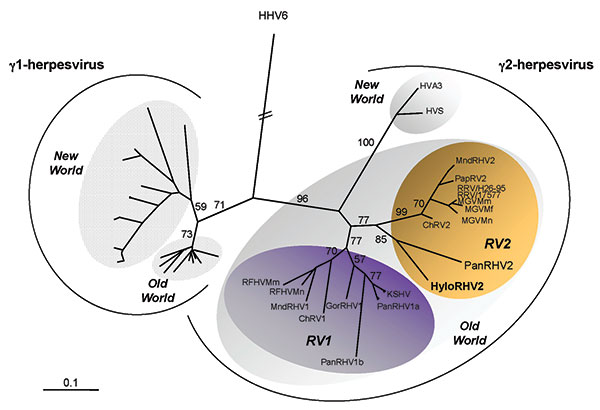Volume 10, Number 5—May 2004
Dispatch
Novel γ-2-Herpesvirus of the Rhadinovirus 2 Lineage in Gibbons
Figure 1

Figure 1. Neighbor-joining protein distance tree for the best 130 amino acids of DNA polymerase residues alignment. DNA sequences (primers DFASA and GDTD1B) (8) were first translated, then aligned by using ClustalX (nonphylogeneticaly informative gaps were manually removed) and analyzed by using the PROTDIST and NEIGHBOR programs in PHYLIP (available from: http://evolution.genetics.washington.edu/phylip.html). Horizontal branch lengths are drawn to scale, with the bar indicating 0.1 amino acid replacements per site. Numbers in each internal branch indicate the percentage of bootstrap samples (of 1,000) in which the cluster is supported (SEQBOOT). Previously published sequences included and their accession numbers are as follows: HyloRHV2 (AY465375); PanRHV2 (AF346490); KSHV (U75698, U93872 and AF005477); PanRHV1a (AF250879 and AF250880); PanRHV1b (AF250881 and AF250882); GorRHV1 (AF250886); MndRHV1 (AF282943); MndRHV2 (AF282937 to AF282940); herpesvirus saimiri (HVS) (M31122); ateline herpesvirus 3 (HVA3) (AF083424); Chlorocebus rhadinovirus 1 (ChRV1) (AJ251573); ChRV2 (AJ251574); retroperitoneal fibromatosis–associated herpesvirus strains from Macaca mulatta (AF005479) and M. nemestrina (AF005478) called here RFHVMm and RFHVMn, respectively; M. mulatta rhadinovirus RRV/17577 (AF083501); rhesus monkey rhadinovirus (RRV/H26-95) (AF029302); baboon γ-herpesvirus (PapRV2) (AY270026); Macaca γ-virus strains from M. mulatta (MGVMm) (AF159033), M. fascicularis (MGVMf) (AF159032), and M. nemestrina (AF159031); and HHV6A (X83413). Other sequences used to construct the phylogenetic trees (especially Epstein-Barr virus and related strains) have been published mainly by Ehlers et al. (9) and are named in the legend of Figure 2.
References
- McGeoch DJ. Molecular evolution of the Gammaherpesvirinae. Philos Trans R Soc Lond B Biol Sci. 2001;356:421–35. DOIPubMedGoogle Scholar
- Wang F, Rivailler P, Rao P, Cho Y. Simian homologues of Epstein-Barr virus. Philos Trans R Soc Lond B Biol Sci. 2001;356:489–97. DOIPubMedGoogle Scholar
- Rasheed S, Rongey RW, Bruszweski J, Nelson-Rees WA, Rabin H, Neubauer RH, Establishment of a cell line with associated Epstein-Barr-like virus from a leukemic orangutan. Science. 1977;198:407–9. DOIPubMedGoogle Scholar
- Ehlers B, Ochs A, Leendertz F, Goltz M, Boesch C, Matz-Rensing K. Novel simian homologues of Epstein-Barr virus. J Virol. 2003;77:10695–9. DOIPubMedGoogle Scholar
- Strand K, Harper E, Thormahlen S, Thouless ME, Tsai C, Rose T, Two distinct lineages of macaque gamma herpesviruses related to the Kaposi’s sarcoma associated herpesvirus. J Clin Virol. 2000;16:253–69. DOIPubMedGoogle Scholar
- Greensill J, Sheldon JA, Renwick NM, Beer BE, Norley S, Goudsmit J, Two distinct gamma-2 herpesviruses in African green monkeys: a second gamma-2 herpesvirus lineage among old world primates? J Virol. 2000;74:1572–7. DOIPubMedGoogle Scholar
- Lacoste V, Mauclere P, Dubreuil G, Lewis J, Georges-Courbot MC, Gessain A. A novel gamma 2-herpesvirus of the Rhadinovirus 2 lineage in chimpanzees. Genome Res. 2001;11:1511–9. DOIPubMedGoogle Scholar
- Schultz ER, Rankin GW Jr, Blanc MP, Raden BW, Tsai CC, Rose TM. Characterization of two divergent lineages of macaque rhadinoviruses related to Kaposi’s sarcoma-associated herpesvirus. J Virol. 2000;74:4919–28. DOIPubMedGoogle Scholar
- Whitby D, Stossel A, Gamache C, Papin J, Bosch M, Smith A, Novel Kaposi’s sarcoma-associated herpesvirus homolog in baboons. J Virol. 2003;77:8159–65. DOIPubMedGoogle Scholar
- Greensill J, Sheldon JA, Murthy KK, Bessonette JS, Beer BE, Schulz TF. A chimpanzee rhadinovirus sequence related to Kaposi’s sarcoma-associated herpesvirus/human herpesvirus 8: increased detection after HIV-1 infection in the absence of disease. AIDS. 2000;14:F129–35. DOIPubMedGoogle Scholar
- Lacoste V, Mauclere P, Dubreuil G, Lewis J, Georges-Courbot MC, Gessain A. KSHV-like herpesviruses in chimps and gorillas. Nature. 2000;407:151–2. DOIPubMedGoogle Scholar
- Engels EA, Sinclair MD, Biggar RJ, Whitby D, Ebbesen P, Goedert JJ, Latent class analysis of human herpesvirus 8 assay performance and infection prevalence in sub-saharan Africa and Malta. Int J Cancer. 2000;88:1003–8. DOIPubMedGoogle Scholar
- Plancoulaine S, Abel L, van Beveren M, Tregouet DA, Joubert M, Tortevoye P, Human herpesvirus 8 transmission from mother to child and between siblings in an endemic population. Lancet. 2000;356:1062–5. DOIPubMedGoogle Scholar
- Rose TM, Schultz ER, Henikoff JG, Pietrokovski S, McCallum CM, Henikoff S. Consensus-degenerate hybrid oligonucleotide primers for amplification of distantly related sequences. Nucleic Acids Res. 1998;26:1628–35. DOIPubMedGoogle Scholar
- Gessain A, Mauclere P, van Beveren M, Plancoulaine S, Ayouba A, Essame-Oyono JL, Human herpesvirus 8 primary infection occurs during childhood in Cameroon, Central Africa. Int J Cancer. 1999;81:189–92. DOIPubMedGoogle Scholar